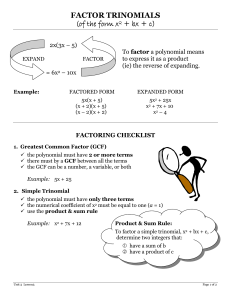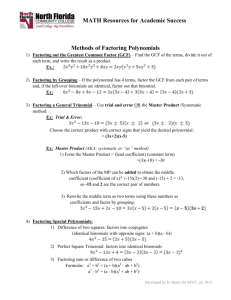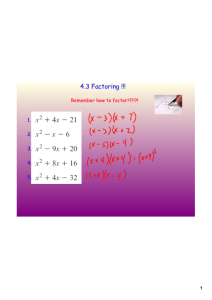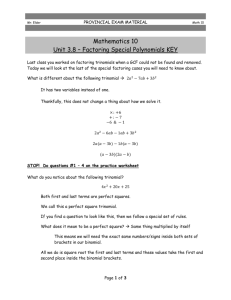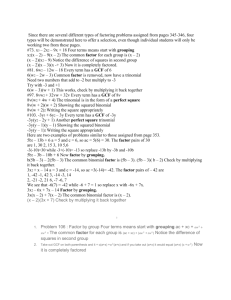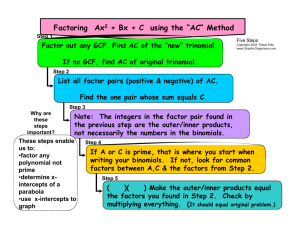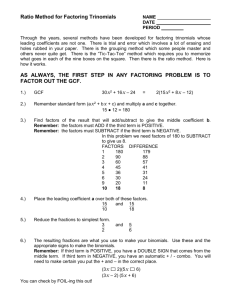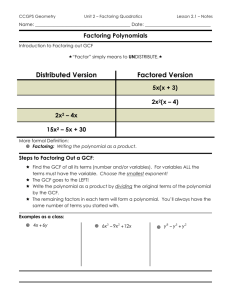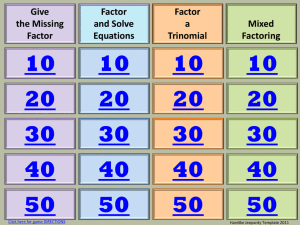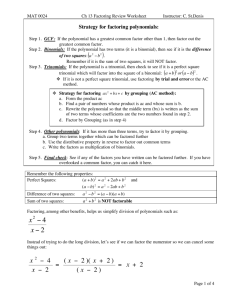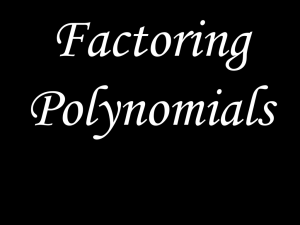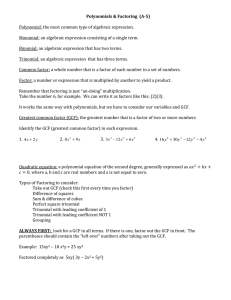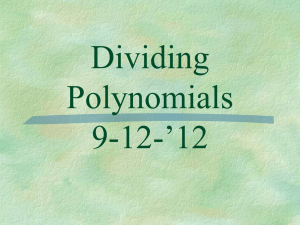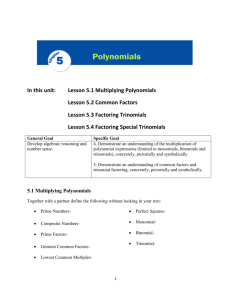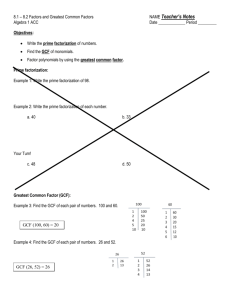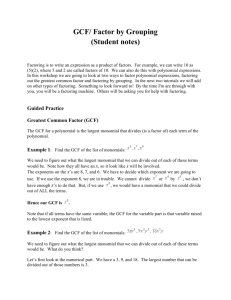Factoring procedure.cwk (WP)
advertisement
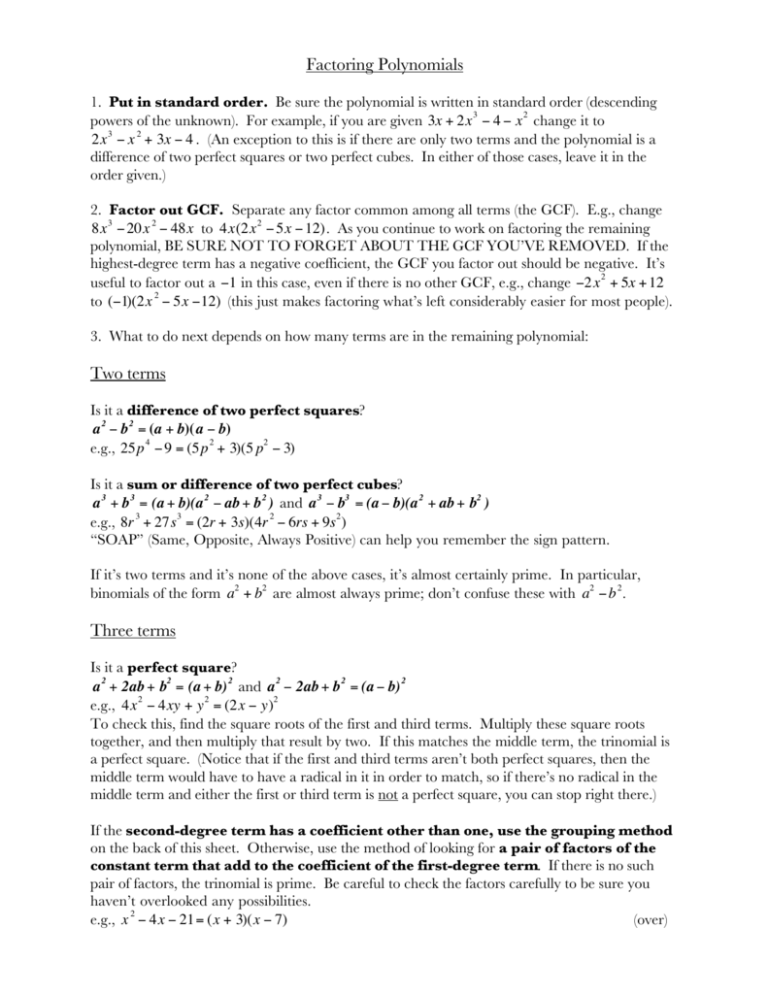
Factoring Polynomials 1. Put in standard order. Be sure the polynomial is written in standard order (descending powers of the unknown). For example, if you are given 3x + 2x 3 − 4 − x 2 change it to 2x 3 − x 2 + 3x − 4 . (An exception to this is if there are only two terms and the polynomial is a difference of two perfect squares or two perfect cubes. In either of those cases, leave it in the order given.) € € 2. Factor out GCF. Separate any factor common among all terms (the GCF). E.g., change 8x 3 − 20x 2 − 48x to 4x(2x 2 − 5x − 12). As you continue to work on factoring the remaining polynomial, BE SURE NOT TO FORGET ABOUT THE GCF YOU’VE REMOVED. If the highest-degree term has a negative coefficient, the GCF you factor out should be negative. It’s useful to factor out a −1 in this case, even if there is no other GCF, e.g., change −2 x 2 + 5x + 12 € to (−1)(2x 2 − 5x −12) (this just makes factoring what’s left considerably easier for most people). € 3. What to € do next depends on how many terms are in the remaining € polynomial: € Two terms Is it a difference of two perfect squares? a 2 − b 2 = (a + b)(a − b) 4 2 2 e.g., 25p − 9 = (5p + 3)(5 p − 3) € Is it a sum or difference of two perfect cubes? a 3 + b 3 = (a + b)(a 2 − ab + b 2 ) and a 3 − b3 = (a − b)(a 2 + ab + b2 ) 3 3 2 2 e.g., 8r + 27s = (2r + 3s)(4r − 6rs + 9s ) “SOAP” (Same, Opposite, Always Positive) can help you remember the sign pattern. € € If it’s two terms and it’s none of the above cases, it’s almost certainly prime. In particular, 2 2 2 2 binomials of the form a + b are almost always prime; don’t confuse these with a − b . € € Three terms € € € € Is it a perfect square? a 2 + 2ab + b2 = (a + b) 2 and a 2 − 2ab + b 2 = (a − b) 2 2 2 2 e.g., 4x − 4xy + y = (2x − y) To check this, find the square roots of the first and third terms. Multiply these square roots together, and then multiply that result by two. If this matches the middle term, the trinomial is € a perfect square. (Notice that if the first and third terms aren’t both perfect squares, then the middle term would have to have a radical in it in order to match, so if there’s no radical in the middle term and either the first or third term is not a perfect square, you can stop right there.) If the second-degree term has a coefficient other than one, use the grouping method on the back of this sheet. Otherwise, use the method of looking for a pair of factors of the constant term that add to the coefficient of the first-degree term. If there is no such pair of factors, the trinomial is prime. Be careful to check the factors carefully to be sure you haven’t overlooked any possibilities. 2 e.g., x − 4x − 21= (x + 3)(x − 7) (over) € Four terms Try to group the four terms into two binomials and look for the GCF of each binomial separately. If you’re left with the same remaining binomial from each of the two original binomials, you can take it out as a common factor. e.g., 2xz + 3yz − 4xy − 6y 2 (2xz + 3yz) − (4 xy + 6y 2 ) z(2x + 3y) − 2y(2x + 3y) (z − 2y)(2x + 3y) € € € € Factoring trinomials by grouping Use this method to factor a trinomial of the form ax 2 + bx + c when a ≠ 1. As an example, we’ll 2 use 6x + 23x − 18. € 1. Find the product of a and c . € In our example we multiply 6 × −18 to get −108 . € 2. List the pairs of factors of that product until you find a pair that adds to b (the coefficient € € of the middle term). Be careful to list the possible pairs of factors methodically to be sure you € € don’t miss the pair you’re looking for. If the product from step 1 is large, you may have to examine the possibilities carefully so you don’t end up making a huge list. If there is no pair of € factors that works, the trinomial is prime. For our example the factors are 27 and −4 . 3. Rewrite the middle term of the original trinomial using the factors from step 2 (the order doesn’t matter). € 6x 2 + 23x − 18 becomes 6x 2 + 27x − 4x − 18. € € € € € 4. Now factor using grouping as in the example for four terms at the top of this page: 6x 2 + 27x − 4x€− 18 (6x 2 + 27x) − (4x + 18) 3x(2x + 9) − 2(2x + 9) (3x − 2)(2x + 9) When using this method, you should always end up with the same binomial remaining in each half of the four-term polynomial after taking out each GCF (i.e., the 2x + 9 in this example). If you don’t, you’ve made a mistake somewhere. € 2009-04-14
